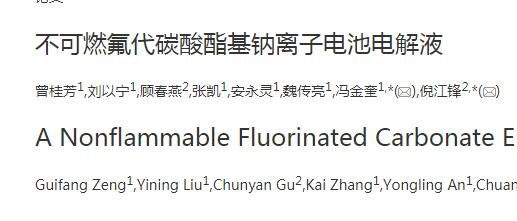intermixture of di-(2, 2, 2 trifluoroethyl) carbonate (TFEC) and fluoroethylene carbonate (FEC) in a 7 : 3 ratio by volume. Its physical and electrochemical properties were studied by ionic conductivity,

ithium-ion batteries (LIBs) are widely used in cellphones, laptops, and electric cars owing to their high energy density and long operational lifetime. However, their further deployment in large-scale energy storage systems is restricted by the uneven distribution of lithium resources (~0.0017% (mass fraction, w) in the Earth's crust). Therefore, alternative energy storage systems composed of abundant elements are of urgent need. Recently, sodium-ion batteries (SIBs) have attracted significant attention and are considered to be a potential alternative for next-generation batteries owing to abundant sodium resources (~2.64% (w) of the Earth's crust), suitable potential (−2.71 V), and low cost. SIBs are similar to LIBs in terms of their physical and electrochemical properties. Previous studies have mainly focused on SIB storage materials, including hard carbon, alloys, and hexacyanoferrate, while the safety of SIBs remains largely unexplored. Similar to LIBs, the current electrolytes used in SIBs are mainly composed of flammable organic carbonate solvents (or ether solvents), sodium salts, and functional additives, which pose possible safety issues. Moreover, the chemical activity of sodium is much higher than that of lithium, leading to a higher risk of fire, thermal runaway, and explosion. To overcome this problem, herein we propose a fluorinated non-flammable electrolyte composed of 0.9 mol∙L−1 NaPF6 (sodium hexafluorophosphate) in an intermixture of di-(2, 2, 2 trifluoroethyl) carbonate (TFEC) and fluoroethylene carbonate (FEC) in a 7 : 3 ratio by volume. Its physical and electrochemical properties were studied by ionic conductivity, direct ignition, cyclic voltammetry, and charge/discharge measurements, demonstrating excellent flame-retarding ability and outstanding compatibility with sodium electrodes. The electrochemical tests showed that the Prussian blue cathode retained a capacity of 84 mAh∙g−1 over 50 cycles in the prepared electrolyte, in contrast to the rapid capacity degradation in a flammable conventional carbonate electrolyte (74 mAh∙g−1 with 57% capacity retention after 50 cycles). To test the practical application of the proposed electrolyte, a hard carbon anode was used and exhibited exceptional performance in this system. The enhancement mechanism was further verified by Fourier transform infrared (FTIR), X-ray diffraction (XRD), and scanning emission microscopy (SEM) investigations. Polycarbonate on the surface of the cathode played an important role for the studied electrolyte system. The polycarbonate may originate from FEC decomposition, which can enhance the ionic conductivity of the solid electrolyte interface (SEI) layer and reduce impedance. Hence, we believe that this proposed electrolyte may provide new opportunities for the design of robust and safe SIBs for next-generation applications.
Contact: Mr Hsu
Phone: +86(0)1815701-8567
Tel: +86(0)570780-5618
Email: sales@fluorio.com
Add: No.5,Longfei Road,Longyou Eco-Tech Development Zone, Quzhou, Zhejiang, China